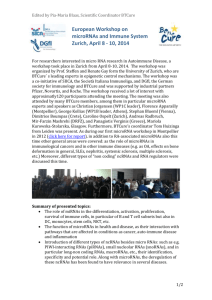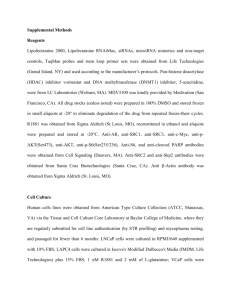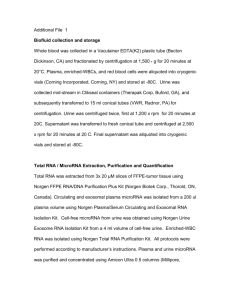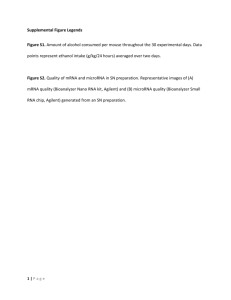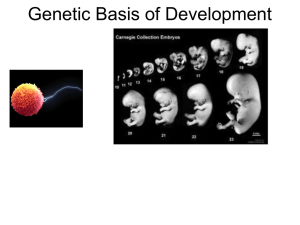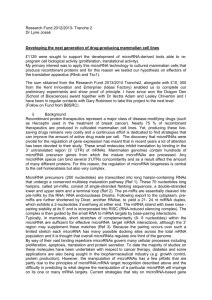GCB 535 / CIS 535: Introduction to Bioinformatics
advertisement
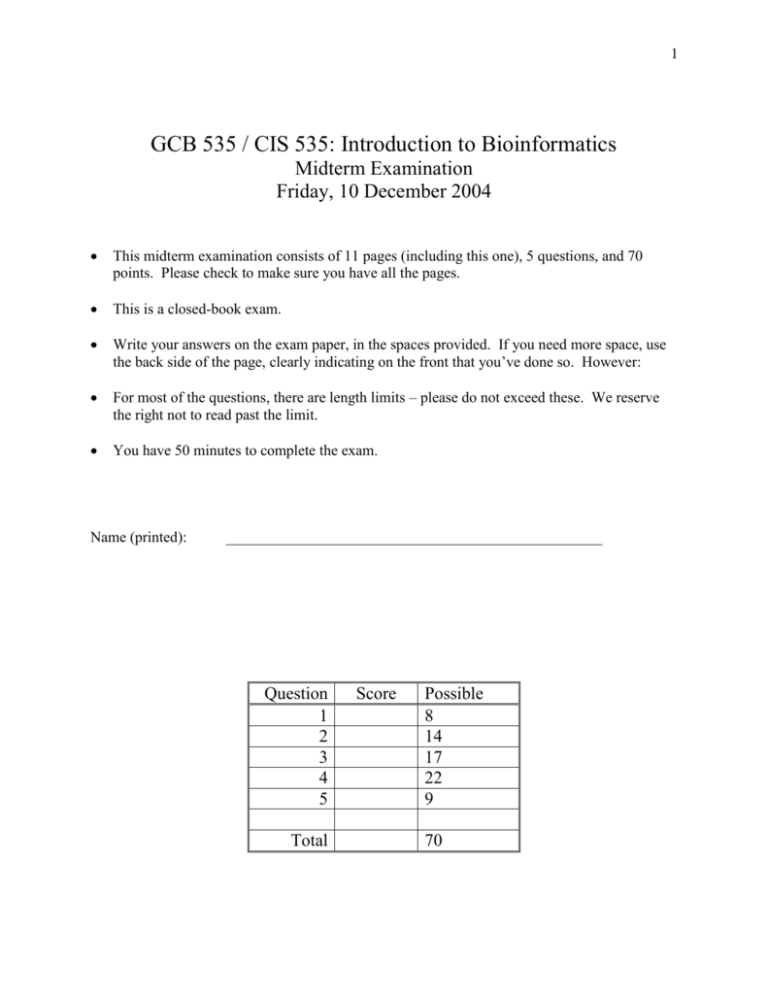
1 GCB 535 / CIS 535: Introduction to Bioinformatics Midterm Examination Friday, 10 December 2004 This midterm examination consists of 11 pages (including this one), 5 questions, and 70 points. Please check to make sure you have all the pages. This is a closed-book exam. Write your answers on the exam paper, in the spaces provided. If you need more space, use the back side of the page, clearly indicating on the front that you’ve done so. However: For most of the questions, there are length limits – please do not exceed these. We reserve the right not to read past the limit. You have 50 minutes to complete the exam. Name (printed): __________________________________________________ Question 1 2 3 4 5 Total Score Possible 8 14 17 22 9 70 2 Question 1 (8 pts) You’ve just joined a lab that is interested in gene regulation in capuchin monkeys. In trying to determine what project you will work on, your advisor suggested that you look at a part of the capuchin genome that contains some HOX genes. Although the capuchin genome has not been completely sequenced, you are able to isolate and align the region of the genome shown in Figure 2 with corresponding regions of the human and chimpanzee genomes. Figure 1: Capuchin monkey * Figure 2: VISTA plot showing alignment between human (top row), chimpanzee (middle row), and capuchin (bottom row); cutoff = 50% sequence similarity a. (4 points) Describe the difference between a synonymous mutation and a nonsynonymous mutation ( 2 sentences). b. (4 points) Mark all of the regions on the VISTA plot where it makes sense to calculate a Ka/Ks ratio. Give an estimate for the Ka/Ks ratio between human and capuchin in the appropriate regions and briefly justify your answer (1 sentence). 3 Question 2 (14 pts) You are particularly interested in the region of high conservation marked with an asterisk (*) around 47,172K. You discover that part of that region encodes a type of regulatory RNA called a microRNA. MicroRNAs are known to inhibit protein translation by binding to the 3’ UTR of a target mRNA. It is believed that any one microRNA will only bind to a small number of genes’ mRNAs. Previous work has already identified potential targets for the human and chimpanzee versions of the microRNA, though interestingly there is low overlap between the targets of the two species. You decide to build a hidden Markov model trained on the first 200 nucleotides of the 3’ UTRs of the human and chimpanzee gene targets. a. (3 points) By using a hidden Markov model, what assumption are you making about the relationship between individual nucleotides in the sequence of a positive target 3’ UTR? ( 2 sentences). b. (4 points) Once you have the hidden Markov model trained, how would you go about using it to find potential targets for the capuchin microRNA? ( 4 sentences). (continued on next page) 4 (Question 2 continued) Your algorithm returns 22 strong candidate 3’ UTRs. Your advisor decides to pull several graduate students off of their thesis work so they can biologically verify these targets for you using an expression assay. They confirm that 10 are indeed targets, and that the remaining 12 are not. c. (3 points) You know that the average number of targets for a microRNA is 30. If you assume that your capuchin microRNA has 30 targets, what was the sensitivity (TP/(TP + FN)) of your hidden Markov model target-finder? Clearly indicate how many true positives and false negatives you have. d. (4 points) You now have a set of 10 genes whose 3’ UTRs are targets for the capuchin microRNA. How would you determine whether the set is functionally significant? I.e., is there any pattern to the sorts of genes that your microRNA regulates? ( 4 sentences). 5 Question 3 (17 pts) Your advisor decides she wants to run a spotted microarray experiment to look at the expression levels of your 10 target genes, along with several other genes, under two conditions: condition A, in which the microRNA has been expressed, and condition B, in which the microRNA is not expressed. In all other respects, the conditions are identical. Table 1 summarizes a subset of the data extracted from the arrays. Condition A (microRNA expressed) Gene Cy3 Cy5 Ratio 10000 1.25 targetA 12500 5000 1.0 targetB 5000 1000 2.4 targetC 2400 16000 0.6 targetD 9600 geneX geneY geneZ 600 950 9000 800 825 4500 0.75 1.25 2.0 Condition B (microRNA not expressed) Gene Cy3 Cy5 Ratio 6300 1.19 targetA 7500 4000 1.1 targetB 4400 1400 2.5 targetC 3500 7500 0.6 targetD 4500 geneX geneY geneZ 10000 3125 1000 700 1250 5000 20.0 2.5 0.2 Table 1: Expression data over the two conditions for four microRNA target genes (targetA, targetB, targetC, targetD) and three non-target genes (geneX, geneY, geneZ) a. (4 points) Is this a loop or common reference style set of microarray experiments? Report the number of microarray experiments that were performed and for each experiment indicate which sample each of the dye colors corresponds to. b. (3 points) Are the results for the target genes what you would expect, given the function of the microRNA? Explain. ( 3 sentences). (continued on next page) 6 (Question 3 continued) You and your advisor notice that geneX, geneY, and geneZ have very different expression profiles in the two conditions, and you hypothesize that geneX, geneY, and geneZ expression levels are regulated by some combination of targetA, targetB, targetC, and targetD. If we model these interactions using a Bayesian network, we might end up with a network structure as shown in Figure 3. microRNA targetA geneX targetB targetC geneY targetD geneZ Figure 3: A possible Bayesian network regulatory structure. Each of the target genes is connected to each of geneX, geneY, and geneZ. c. (3 points) Using the term “conditionally independent,” make an observation about the relationship between geneX and the microRNA (1 sentence). (continued on next page) 7 (Question 3 continued) You consult a colleague who has been studying geneZ, and you find out that geneZ regulates both geneX and geneY, and that neither geneX or geneY is regulated by any other gene or regulatory factor. In addition, you find out that targetA regulates geneZ, and geneZ is not regulated by any other gene or regulatory factor. d. (4 points) Redraw the network taking into account this new information (you may abbreviate targetA as ‘A’, geneZ as ‘Z’, etc.) e. (3 points) In your new network, are there any two genes (including the microRNA) that are independent of each other – that is, you don’t need to condition on any other gene in order to make an independence claim? If so, list the two genes. Explain your answer ( 2 sentences). 8 Question 4 (22 points) You decide that you are ready to do some proteomic analysis to determine whether targetA’s protein levels are downregulated when the microRNA is expressed. Your run a 2-dimensional gel electrophoresis on a proteomic sample from Condition A (microRNA expressed) and a separate gel on a proteomic sample from Condition B (microRNA not expressed). Each sample is extracted in the same way from the same type of capuchin epithelial cells, and differ only in the expression level of the microRNA. Figure 4 shows a portion of the resulting gels corresponding to the predicted molecular weight and isoelectric point of the targetA protein product. Condition A Condition B Figure 4: The same portion of the 2D gel run on each of the two conditions. a. (4 points) Do the gels support your hypothesis that the microRNA suppresses translation of targetA protein? Explain. Is there any other mechanism that could account for the different gels, assuming that there were no technical errors in running the gels? Explain. ( 4 sentences). b. (2 points) You extract the protein sample from the spots of interest in Condition A and B and run both samples through a liquid chromatography column. What does this accomplish and why would you want to do this? ( 3 sentences) (continued on next page) 9 (Question 4 continued) You run a tandem mass spectrometry experiment after trypsin digest of each of the protein samples separately. You obtain the following full scans (i.e., the first MS in a tandem MS/MS). * Figure 5: A full scan MS spectrum from the Condition A (microRNA expressed) protein sample. * Figure 6: A full scan MS spectrum from the Condition B (no microRNA expression) protein sample. c. (3 points) What does each peak in the scan represent? (1 sentence) d. (6 points) You visually compare the spectra and are relatively sure that they represent the same protein, but now you want to do a database search to figure out if they both correspond to the protein product of targetA. How would you go about doing this using a mass fingerprinting method based only on the full scan? Describe generally the process of mass fingerprinting and what sort of database you will use. How accurate will this procedure be, and why? ( 4 sentences) (continued on next page) 10 (Question 4 continued) You also want to perform a sequence tag search using the MS scans on the ionization fragments from the first MS. You obtain the following spectra – the second MS in the tandem MS/MS – from the peaks on the two conditions marked with an asterisk (*) on the full scans. Figure 7: An MS-MS spectrum from the (*) marked Condition A (microRNA expressed) peptide. Figure 8: An MS-MS spectrum from the (*) marked Condition B (no microRNA expression) peptide. e. (3 points) What does each peak in the scan represent? (1 sentence) f. (4 points) From the Condition A spectrum you obtain a sequence tag of (613.68)LAN(913.02) and from the Condition B spectrum you obtain a sequence tag of (675.74)ALS(947.07). Explain why these tags are different, given that we believe that the two peptide fragments in the two conditions are identical ( 3 sentences). 11 Question 5 (9 points) For targetD, you discover that there is no decrease in protein levels when the microRNA is expressed in your cell samples. You screen around 100 more cell samples collected from different capuchin individuals, and you find that some of the cells do exhibit decreased targetD protein levels when the microRNA is expressed, but some don’t. Your advisor wants you to use linear regression to build a classifier to predict whether the microRNA will have an effect on targetD given an individual’s genetic profile. The features that you use will be 6 quantitative biochemical traits that seem to vary from capuchin to capuchin. You’ve measured these traits in all of the samples you’ve assayed above, though you don’t know which ones are important for predicting whether the microRNA will inhibit targetD translation. a. (2 points) If you perform linear regression using all of the traits, how would you be able to tell which traits are informative and which ones are not? (1 sentence). b. (3 points) Describe how you would use the results of the linear regression to predict whether the microRNA will have an effect on targetD in a new cell sample. ( 3 sentences). c. (4 points) What would be the advantage of using a linear regression model rather than a knearest-neighbors classifier? When might you prefer the k-nearest neighbors classifer? ( 4 sentences).
